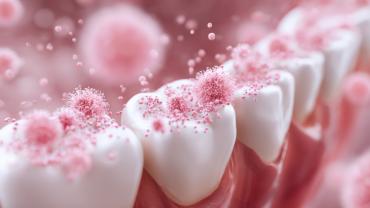
Dietary nitrate (NO3-) is naturally found in many vegetables, with spinach, beetroot, and celery being the richest sources, often exceeding 2,500 mg of inorganic nitrate per kg. Since humans lack the enzyme nitrate reductase, NO3- is biologically inert when consumed; however, commensal oral bacteria are able to convert it to nitrite (NO2-). Nitrite is further reduced in the low-oxygen and low-pH environment of the stomach to nitric oxide (NO), which is a potent vasodilator. This process is referred to as the nitrate-nitrite-NO (or the entero-salivary) pathway. By interacting with the oral microbiome, nitrate can act as a prebiotic and selectively promote the growth of beneficial nitrate-reducing bacteria like Neisseria and Rothia, which may play an important role in oral and dental health. Additionally, nitrate exposure may play a role in mitigating pathogenic bacteria like Prevotella, Veillonella, and Streptococcus, which have been associated with periodontal conditions and dental caries.
A recent study published in the journal Biofilms and Microbiomes presents a small pilot trial (n = 9) investigating whether delivering dietary nitrates in a gum format could extend contact time (“hang-time”) in the mouth and enhance their impact on the oral microbiome. Healthy adults identified as low nitrate reducers (with salivary nitrite < 20 µM) consented to chewing a prebiotic nitrate and ascorbic acid formulated chewing gum delivering 1.86 mM of NO3- daily (0.62 mM per dose, chewed three times for 5-10 minutes, at about 2.5-hour intervals).
Saliva samples were collected before and after the intervention for metagenomic sequencing and mapping of all the DNA present in the samples. Within hours, a significant increase was observed in the oral beneficial nitrate-reducing bacteria species Neisseria flavescens, Neisseria subflava, Haemophilus parainfluenzaea, and Rothia mucilaginosa. Within one day, a significant decrease was observed in the pathogenic species Prevotella melaninogenica and Prevotella histicola. Even though periodontitis-associated species were present at less than 1% abundance in the baseline saliva sampling, the authors reported additional downward trends for Porphyromonas gingivalis, Fusobacterium nucleatum, and Tannerella forsythia, suggesting that these species were also sensitive to the prebiotic nitrate chewing gum. Although direct NO or nitrite measurements were not reported as part of this study, the microbial profile changes align with potential benefits for oral health.
The authors concluded that these initial findings suggest that intermittent chewing of a dietary nitrate source over the course of hours may begin to move the oral microbiome towards more beneficial microbiota within one day. These results imply that extending the residence time (or “hang-time”) of dietary nitrate in the mouth, for example with slow-release gum or lozenges, may shift the oral microbiome toward nitrate-reducing and NO-promoting beneficial bacteria, while at the same time limiting pathogenic species, potentially supporting oral and cardiovascular health.
Even though further clinical evidence is needed, this study highlights that chewing gum may provide a novel way to deliver prebiotic nitrate topically, where it can interact directly with oral bacteria that convert it into nitrite and subsequently help promote conversion into the beneficial nitric oxide. This mechanism may support both oral health (through microbiome balance and dental care) and systemic vascular health (via nitric oxide production), especially when combined with other nitrate-containing foods or supplements.
Learn more about nitric oxide, the oral microbiome, and cardiovascular health:
Exploring the Dual Pathways and Nutrients for Enhanced Nitric Oxide Production
The Role of the Oral Microbiome on Nitric Oxide Production and Healthy Blood Pressure
Nitric Oxide: The Key to Healthy Blood Pressure
Vitamin C: Fueling Nitric Oxide for Healthy Blood Vessels
By Antonia Toupet, PhD